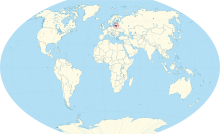
A | B | C | D | E | F | G | H | CH | I | J | K | L | M | N | O | P | Q | R | S | T | U | V | W | X | Y | Z | 0 | 1 | 2 | 3 | 4 | 5 | 6 | 7 | 8 | 9
This article may be too long to read and navigate comfortably. When this tag was added, its readable prose size was 18,000 words. (June 2023) |
Republic of Lithuania Lietuvos Respublika (Lithuanian) | |
|---|---|
| Anthem: Tautiška giesmė "National Hymn" | |
Location of Lithuania (dark green) – in Europe (green & dark grey) | |
| Capital and largest city | Vilnius 54°41′N 25°19′E / 54.683°N 25.317°E |
| Official languages | Lithuanian[1] |
| Ethnic groups (2023[2]) |
|
| Religion (2021[3]) |
|
| Demonym(s) | Lithuanian |
| Government | Unitary semi-presidential republic[4][5][6][7] |
| Gitanas Nausėda | |
| Ingrida Šimonytė | |
| Viktorija Čmilytė-Nielsen | |
| Legislature | Seimas |
| Formation | |
| 9 March 1009 | |
| 1236 | |
• Coronation of Mindaugas | 6 July 1253 |
| 2 February 1386 | |
• Commonwealth created | 1 July 1569 |
| 24 October 1795 | |
| 16 February 1918 | |
| 11 March 1990 | |
• Joined the European Union | 1 May 2004 |
| Area | |
• Total | 65,300 km2 (25,200 sq mi) (121st) |
• Water (%) | 1.98 (2015)[8] |
| Population | |
• 2024 estimate | |
• Density | 44/km2 (114.0/sq mi) (138th) |
| GDP (PPP) | 2024 estimate |
• Total | |
• Per capita | |
| GDP (nominal) | 2024 estimate |
• Total | |
• Per capita | |
| Gini (2022) | medium |
| HDI (2022) | very high (35th) |
| Currency | Euro (€) (EUR) |
| Time zone | UTC+2 (EET) |
• Summer (DST) | UTC+3 (EEST) |
| Date format | yyyy-mm-dd (CE) |
| Driving side | right |
| Calling code | +370 |
| ISO 3166 code | LT |
| Internet TLD | .lta |
Website lithuania | |
| |
Lithuania (/ˌlɪθjuˈeɪniə/ ⓘ LITH-yoo-AYN-ee-ə;[13] Lithuanian: Lietuva [lʲɪɛtʊˈvɐ]), officially the Republic of Lithuania (Lithuanian: Lietuvos Respublika [lʲɪɛtʊˈvoːs rʲɛsˈpʊblʲɪkɐ]), is a country in the Baltic region of Europe.[a] It is one of three Baltic states and lies on the eastern shore of the Baltic Sea. It borders Latvia to the north, Belarus to the east and south, Poland to the south, and Russia to the southwest,[b] with a maritime border with Sweden to the west. Lithuania covers an area of 65,300 km2 (25,200 sq mi), with a population of 2.86 million. Its capital and largest city is Vilnius; other major cities are Kaunas, Klaipėda, Šiauliai and Panevėžys. Lithuanians belong to the ethnolinguistic group of the Balts and speak Lithuanian, one of only a few living members of the Baltic branch of the Indo-European language family, which is also the most widely spoken language of the branch.
For millennia, the southeastern shores of the Baltic Sea were inhabited by various Baltic tribes. In the 1230s, Lithuanian lands were united for the first time by Mindaugas, who formed the Kingdom of Lithuania on 6 July 1253. Subsequent expansion and consolidation resulted in the Grand Duchy of Lithuania, which by the 14th century was the largest country in Europe.[20] In 1386, the Grand Duchy entered into a de facto personal union with the Crown of the Kingdom of Poland. The two realms were united into the bi-confederal Polish-Lithuanian Commonwealth in 1569, forming one of the largest and most prosperous states in Europe. The Commonwealth lasted more than two centuries, until neighbouring countries gradually dismantled it between 1772 and 1795, with the Russian Empire annexing most of Lithuania's territory. Towards the end of World War I, Lithuania declared Independence in 1918, founding the modern Republic of Lithuania. In World War II, Lithuania was occupied by the Soviet Union, then by Nazi Germany, before being reoccupied by the Soviets in 1944. Lithuanian armed resistance to the Soviet occupation lasted until the early 1950s. On 11 March 1990, a year before the formal dissolution of the Soviet Union, Lithuania became the first Soviet republic to break away when it proclaimed the restoration of its independence.[21]
Lithuania is a developed country with a high income, advanced economy, ranking 35th in the Human Development Index. Lithuania is a member of the European Union, the Council of Europe, the eurozone, the Nordic Investment Bank, the Schengen Agreement, NATO, and OECD. It also participates in the Nordic-Baltic Eight (NB8) regional co-operation format.
Etymology
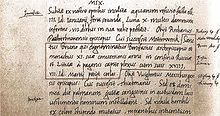
The first known record of the name of Lithuania (Lithuanian: Lietuva) is in a 9 March 1009 story of Saint Bruno in the Quedlinburg Chronicle.[22] The Chronicle recorded a Latinized form of the name Lietuva: Litua[23] (pronounced ). Due to lack of reliable evidence, the true meaning of the name is unknown. Scholars still debate the meaning of the word and there are a few plausible versions.[24]
Since Lietuva has a suffix (-uva), there should be a corresponding original word with no suffix.[24] A likely candidate is Lietā. Because many Baltic ethnonyms originated from hydronyms, linguists have searched for its origin among local hydronyms. Usually, such names evolved through the following process: hydronym → toponym → ethnonym.[25] Lietava, a small river not far from Kernavė, the core area of the early Lithuanian state and a possible first capital of the eventual Grand Duchy of Lithuania, is usually credited as the source of the name.[25] However, the river is very small and some find it improbable that such a small and local object could have lent its name to an entire nation. On the other hand, such naming is not unprecedented in world history.[26]
Artūras Dubonis proposed another hypothesis,[27] that Lietuva relates to the word leičiai (plural of leitis). From the middle of the 13th century, leičiai were a distinct warrior social group of the Lithuanian society subordinate to the Lithuanian ruler or the state itself. The word leičiai is used in 14–16th century historical sources as an ethnonym for Lithuanians (but not Samogitians) and is still used, usually poetically or in historical contexts, in the Latvian language, which is closely related to Lithuanian.[28][29][30]
History
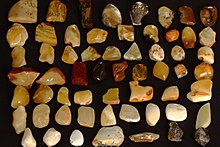
The first people settled in the territory of Lithuania after the last glacial period in the 10th millennium BC: Kunda, Neman and Narva cultures.[31] They were traveling hunters and did not form stable settlements. In the 8th millennium BC, the climate became much warmer, and forests developed. The inhabitants of what is now Lithuania then travelled less and engaged in local hunting, gathering and fresh-water fishing. Agriculture did not emerge until the 3rd millennium BC due to a harsh climate and terrain and a lack of suitable tools to cultivate the land. Crafts and trade also started to form at this time. Over a millennium, the Indo-Europeans, who arrived in the 3rd – 2nd millennium BC, mixed with the local population and formed various Baltic tribes.[32]
The Baltic tribes did not maintain close cultural or political contacts with the Roman Empire,[33] but they did maintain trade contacts (see Amber Road). Tacitus, in his study Germania, described the Aesti people, inhabitants of the south-eastern Baltic Sea shores who were probably Balts, around the year 97 AD. The Western Balts differentiated and became known to outside chroniclers first. Ptolemy in the 2nd century AD knew of the Galindians and Yotvingians, and early medieval chroniclers mentioned Old Prussians, Curonians and Semigallians.[34]
The Lithuanian language is considered to be very conservative for its close connection to Indo-European roots. It is believed to have differentiated from the Latvian language, the most closely related existing language, around the 7th century.[35] Traditional Lithuanian pagan customs and mythology, with many archaic elements, were long preserved. Rulers' bodies were cremated up until the conversion to Christianity: the descriptions of the cremation ceremonies of the grand dukes Algirdas and Kęstutis have survived.[36]
Grand Duchy of Lithuania
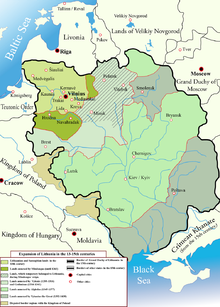
From the 9th to the 11th centuries, coastal Balts were subjected to raids by the Vikings,[38] and the kings of Denmark collected tribute at times.[citation needed] During the 10–11th centuries, Lithuanian territories were among the lands paying tribute to Kievan Rus', and Yaroslav the Wise was among the Ruthenian rulers who invaded Lithuania (from 1040).[citation needed] From the mid-12th century, it was the Lithuanians who were invading Ruthenian territories. In 1183, Polotsk and Pskov were ravaged, and even the distant and powerful Novgorod Republic was repeatedly threatened by the excursions from the emerging Lithuanian war machine toward the end of the 12th century.[39]
From the late 12th century, an organized Lithuanian military force existed; it was used for external raids, plundering and the gathering of slaves. Such military and pecuniary activities fostered social differentiation and triggered a struggle for power in Lithuania. This initiated the formation of early statehood, from which the Grand Duchy of Lithuania developed.[40][41] The disparate Lithuanian tribes along the Nemunas were united into the Lithuanian state by 1219, at the latest.[42] The only Lithuanian Roman Catholic king, Mindaugas, was baptised as a Roman Catholic in 1251 and crowned as King of Lithuania on 6 July 1253.[43]
After his assassination in 1263, pagan Lithuania was a target of the Christian crusades of the Teutonic Knights and the Livonian Order. The siege of Pilėnai is noted for the Lithuanians' defense against the intruders. Despite the devastating century-long struggle with the Orders, the Grand Duchy of Lithuania expanded rapidly, overtaking former Ruthenian principalities of Kievan Rus'.[44]
On 22 September 1236, the Battle of Saulė between Samogitians and the Livonian Brothers of the Sword took place close to Šiauliai. The Livonian Brothers were defeated during it and their further conquest of the Balts lands were stopped.[45] The battle inspired rebellions among the Curonians, Semigallians, Selonians, Oeselians, tribes previously conquered by the Sword-Brothers. Some thirty years' worth of conquests on the left bank of Daugava were lost.[46] In 2000, the Lithuanian and Latvian parliaments declared 22 September to be the Day of Baltic Unity.[47]

According to the legend, Grand Duke Gediminas was once hunting near the Vilnia River; tired after the successful hunt, he settled in for the night and dreamed of a huge Iron Wolf standing on top a hill and howling as strong and loud as a hundred wolves. Krivis (pagan priest) Lizdeika interpreted the dream that the Iron Wolf represents Vilnius Castles. Gediminas, obeying the will of the gods, built the city and gave it the name Vilnius – from the stream of the Vilnia River.[48]
In 1362 or 1363, Grand Duke Algirdas achieved a decisive victory in the Battle of Blue Waters against the Golden Horde and stopped its further expansion in the present-day Ukraine.[49] The victory brought the city of Kyiv and a large part of present-day Ukraine, including sparsely populated Podolia and Dykra, under the control of the expanding Grand Duchy of Lithuania.[50] After taking Kyiv, Lithuania became a direct neighbor and rival of the Grand Duchy of Moscow.[51]
By the end of the 14th century, Lithuania was one of the largest countries in Europe and included present-day Belarus, Ukraine, and parts of Poland and Russia.[52] The geopolitical situation between the west and the east determined the multicultural and multi-confessional character of the Grand Duchy of Lithuania. The ruling elite practised religious tolerance and the Chancery Slavonic language was used as an auxiliary language to Latin for official documents.[53]
In 1385, the Grand Duke Jogaila accepted Poland's offer to become its king. Jogaila embarked on gradual Christianization of Lithuania and established a personal union between Poland and Lithuania. Lithuania was one of the last pagan areas of Europe to adopt Christianity. While territories to the north had been Christianized in 1186 by Western merchants and missionaries who formed the Order of the Brothers and the Sword to spread Christianity through military organization, the Lithuanians had defeated the Order's militant efforts in 1236.[54][55]

After two civil wars, Vytautas the Great became the Grand Duke of Lithuania in 1392. During his reign, Lithuania reached the peak of its territorial expansion, centralization of the state began, and the Lithuanian nobility became increasingly prominent in state politics. In the great Battle of the Vorskla River in 1399, the combined forces of Tokhtamysh and Vytautas were defeated by the Mongols. Thanks to close cooperation, the armies of Lithuania and Poland achieved a victory over the Teutonic Knights in 1410 at the Battle of Grunwald, one of the largest battles of medieval Europe.[56][57][58]
Since the 14th–15th centuries patrilineal members of the Lithuanian ruling Gediminids dynasty ruled not only Lithuania, but also Poland, Hungary, Croatia, Bohemia, and Moldavia (George Koriatovich).[59][60] During the inaugurations of Lithuanian monarchs until 1569, Gediminas' Cap was placed on the monarch's head by the Bishop of Vilnius in Vilnius Cathedral.[61]
In January 1429, at the Congress of Lutsk Vytautas received the title of King of Lithuania with the backing of Sigismund, Holy Roman Emperor, but the envoys who were transporting the crown were stopped by Polish magnates in autumn of 1430. Another crown was sent, but Vytautas died in the Trakai Island Castle several days before it reached Lithuania. He was buried in the Cathedral of Vilnius.[62]
After the deaths of Jogaila and Vytautas, the Lithuanian nobility attempted to break the union between Poland and Lithuania, independently selecting Grand Dukes from the Jagiellon dynasty. But, at the end of the 15th century, Lithuania was forced to seek a closer alliance with Poland when the growing power of the Grand Duchy of Moscow threatened Lithuania's Russian principalities and sparked the Muscovite–Lithuanian Wars and the Livonian War.

On 8 September 1514, the Battle of Orsha between Lithuanians, commanded by the Grand Hetman Konstanty Ostrogski, and Muscovites was fought. According to Rerum Moscoviticarum Commentarii by Sigismund von Herberstein, the primary source for information on the battle, the much smaller army of Poland–Lithuania (under 30,000 men) defeated a force of 80,000 Muscovite soldiers, capturing their camp and commander.[63] The battle destroyed a military alliance against Lithuania and Poland. Thousands of Muscovites were captured as prisoners and used as labourers in the Lithuanian manors, while Konstanty Ostrogski delivered the captured Muscovite flags to the Cathedral of Vilnius.[64][65]
The Livonian War was ceased for ten years with a Truce of Yam-Zapolsky signed on 15 January 1582 according to which the already Polish–Lithuanian Commonwealth recovered Livonia, Polotsk and Velizh, but transferred Velikiye Luki to the Tsardom of Russia. The truce was extended for twenty years in 1600, when a diplomatic mission to Moscow led by Lew Sapieha concluded negotiations with Tsar Boris Godunov.[66] The truce was broken when the Poles invaded Muscovy in 1605.
Polish–Lithuanian Commonwealth
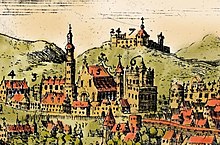
The Polish–Lithuanian Commonwealth was created in 1569 by the Union of Lublin. As a member of the Commonwealth, Lithuania retained its institutions, including a separate army, currency, and statutory laws – the Statute of Lithuania.[67] Eventually Polonization affected all aspects of Lithuanian life: politics, language, culture, and national identity. From the mid-16th to the mid-17th centuries, culture, arts, and education flourished, fueled by the Renaissance and the Protestant Reformation. From 1573, the Kings of Poland and Grand Dukes of Lithuania were elected by the nobility, who were granted ever-increasing Golden Liberties. These liberties, especially the liberum veto, led to anarchy and the eventual dissolution of the state.
The Commonwealth reached its Golden Age in the early 17th century. Its powerful parliament was dominated by nobles who were reluctant to get involved in the Thirty Years' War; this neutrality spared the country from the ravages of a political-religious conflict that devastated most of contemporary Europe. The Commonwealth held its own against Sweden, the Tsardom of Russia, and vassals of the Ottoman Empire, and even launched successful expansionist offensives against its neighbours. In several invasions during the Time of Troubles, Commonwealth troops entered Russia and managed to take Moscow and hold it from 27 September 1610 to 4 November 1612, when they were driven out after a siege.[68]
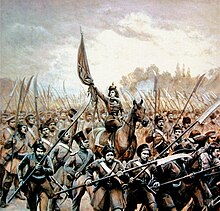
In 1655, after the extinguishing battle, for the first time in history the Lithuanian capital Vilnius was taken by a foreign army.[69] The Russian army looted the city, splendid churches, and manors. Between 8,000 and 10,000 citizens were killed; the city burned for 17 days. Those who returned after the catastrophe could not recognise the city. The Russian occupation of the Grand Duchy of Lithuania lasted up to 1661. Many artefacts and cultural heritage were either lost or looted, significant parts of the state archive – Lithuanian Metrica, collected since the 13th century, were lost and the rest was moved out of the country. During the Northern Wars (1655–1661), the Lithuanian territory and economy were devastated by the Swedish army. Almost all territory of the Grand Duchy of Lithuania was occupied by Swedish and Russian armies. This period is known as Tvanas (The Deluge).
Before it could fully recover, Lithuania was ravaged during the Great Northern War (1700–1721). The war, a plague, and a famine caused the deaths of approximately 40% of the country's population.[70] Foreign powers, especially Russia, became dominant in the domestic politics of the Commonwealth.[71] Numerous fractions among the nobility used the Golden Liberties to prevent any reforms.[71]
The Constitution of 3 May 1791 was adopted by the Great Sejm (parliament) of the Polish–Lithuanian Commonwealth trying to save the state. The legislation was designed to redress the Commonwealth's political defects due to the system of Golden Liberties, also known as the "Nobles' Democracy," which had conferred disproportionate rights on the nobility (Szlachta) and over time had corrupted politics. The constitution sought to supplant the prevailing anarchy fostered by some of the country's magnates with a more democratic constitutional monarchy. It introduced elements of political equality between townspeople and nobility, and placed the peasants under the protection of the government, thus mitigating the worst abuses of serfdom. It banned parliamentary institutions such as the liberum veto, which had put the Sejm at the mercy of any deputy who could revoke all the legislation that had been passed by that Sejm. It was drafted in relation to a copy of the United States Constitution.[72][73][74] It is regarded as the world's second-oldest codified national governmental constitution after the 1787 U.S. Constitution.[71]
Russian Empire

Eventually, the Commonwealth was partitioned in 1772, 1793, and 1795 by the Russian Empire, Prussia, and the Habsburg monarchy.
The largest area of Lithuanian territory became part of the Russian Empire. After the unsuccessful uprisings in 1831 and 1863, the Tsarist authorities implemented a number of Russification policies. In 1840 the Third Statute of Lithuania was abolished. They banned the Lithuanian press, closed cultural and educational institutions and made Lithuania part of a new administrative region called Northwestern Krai. The Russification failed, owing to an extensive network of Lithuanian book smugglers and secret Lithuanian homeschooling.[75]
After the Russo-Turkish War (1877–1878), when German diplomats assigned what were seen as Russian spoils of war to Turkey, the relationship between Russia and the German Empire became complicated. The Russian Empire resumed the construction of fortresses at its western borders for defence against a potential invasion from Germany in the West. Large numbers of Lithuanians went to the United States in 1867–1868 after a famine.[76] On 7 July 1879 the Russian Emperor Alexander II approved a proposal from the Russian military leadership to build the largest "first-class" defensive structure in the entire state – the 65 km2 (25 sq mi) Kaunas Fortress.[77]
Simonas Daukantas promoted a return to Lithuania's pre-Commonwealth traditions, which he depicted as a Golden Age of Lithuania and a renewal of the native culture, based on the Lithuanian language and customs. With those ideas in mind, he wrote already in 1822 a history of Lithuania in Lithuanian – Darbai senųjų lietuvių ir žemaičių (The Deeds of Ancient Lithuanians and Samogitians), though it was not published at that time. A colleague of S. Daukantas, Teodor Narbutt wrote in Polish a voluminous Ancient History of the Lithuanian Nation (1835–1841), where he likewise expounded and expanded further on the concept of historic Lithuania, whose days of glory had ended with the Union of Lublin in 1569. Narbutt, invoking German scholarship, pointed out the relationship between the Lithuanian and Sanskrit languages. A Lithuanian National Revival, inspired by the ancient Lithuanian history, language and culture, laid the foundations of the modern Lithuanian nation and independent Lithuania.
20th and 21st centuries
1918–1939
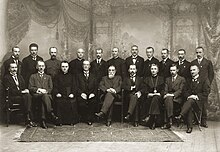
As a result of the Great Retreat during World War I, Germany occupied the entire territory of Lithuania and Courland by the end of 1915.[78] A new administrative entity, Ober Ost, was established. Lithuanians lost all political rights they had gained: personal freedom was restricted, and at the beginning, the Lithuanian press was banned.[79] However, the Lithuanian intelligentsia tried to take advantage of the existing geopolitical situation and began to look for opportunities to restore Lithuania's independence. On 18–22 September 1917, the Vilnius Conference elected the 20-member Council of Lithuania. The council adopted the Act of Independence of Lithuania on 16 February 1918 which proclaimed the restoration of the independent state of Lithuania governed by democratic principles, with Vilnius as its capital. The state of Lithuania which had been built within the framework of the Act lasted from 1918 until 1940.

Following the capitulation of Germany in November 1918, the first Provisional Constitution of Lithuania was adopted and the first government of Prime Minister Augustinas Voldemaras was organized. At the same time, the army and other state institutions began to be organized. Lithuania fought three wars of independence: against the Bolsheviks who proclaimed the Lithuanian Soviet Socialist Republic, against the Bermontians, and against Poland.[80][81] As a result of the staged Żeligowski's Mutiny in October 1920, Poland took control of Vilnius Region and annexed it as Wilno Voivodeship in 1922.[82] Lithuania continued to claim Vilnius as its de jure capital (the de facto, provisional capital being Kaunas) and relations with Poland remained particularly tense and hostile for the entire interwar period. In January 1923, Lithuania staged the Klaipėda Revolt and captured Klaipėda Region (Memel territory) which was detached from East Prussia by the Treaty of Versailles. The region became an autonomous region of Lithuania.
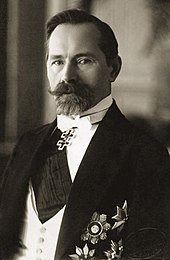
On 15 May 1920, the first meeting of the democratically elected constituent assembly took place. The documents it adopted, i. e. the temporary (1920) and permanent (1922) constitutions of Lithuania, strove to regulate the life of the new state. Land, finance, and educational reforms started to be implemented. The currency of Lithuania, the Lithuanian litas, was introduced. The University of Lithuania was opened.[83] All major public institutions had been established. As Lithuania began to gain stability, foreign countries started to recognize it. In 1921 Lithuania was admitted to the League of Nations.[84]
On 17 December 1926, a military coup d'état took place, resulting in the replacement of the democratically elected government with a conservative authoritarian government led by Antanas Smetona. Augustinas Voldemaras was appointed to form a government. The so-called authoritarian phase had begun strengthening the influence of one party, the Lithuanian Nationalist Union, in the country. In 1927, the Seimas was dissolved.[85] A new constitution was adopted in 1928, which consolidated presidential powers. Gradually, opposition parties were banned, censorship was tightened, and the rights of national minorities were narrowed.[86][87] The only democratically elected body that continued to exist at the time was a Parliament of the Klaipėda Region.

On 15 July 1933, Steponas Darius and Stasys Girėnas, Lithuanian pilots, emigrants to the United States, made a significant flight in the history of world aviation. They flew across the Atlantic Ocean, covering a distance of 6,411 km (3,984 mi) without landing, in 37 hours and 11 minutes (172.4 km/h (107.1 mph)). In terms of comparison, as far as the distance of non-stop flights was concerned, their result ranked second only to that of Russell Boardman and John Polando.
The provisional capital Kaunas, which was nicknamed Little Paris, and the country itself had a Western standard of living with sufficiently high salaries and low prices. At the time, qualified workers there were earning very similar real wages as workers in Germany, Italy, Switzerland and France, the country also had a surprisingly high natural increase in population of 9.7 and the industrial production of Lithuania increased by 160% from 1913 to 1940.[88][89]
The situation was aggravated by the global economic crisis.[90] The purchase price of agricultural products had declined significantly. In 1935, farmers began strikes in Suvalkija and Dzūkija. In addition to economic ones, political demands were made. The government cruelly suppressed the unrest. In the spring of 1936, four peasants were sentenced to death for starting the riots.[91]
1939–1944
On 20 March 1939, after years of rising tensions, Lithuania was handed an ultimatum by Nazi Germany demanding it relinquish the Klaipėda Region. Two days later, the Lithuanian government accepted the ultimatum.[92] When Nazi Germany and Soviet Union concluded the Molotov–Ribbentrop Pact, Lithuania was initially assigned to the German sphere of influence but was later transferred to the Soviet sphere. At the outbreak of World War II, Lithuania declared neutrality.[93]
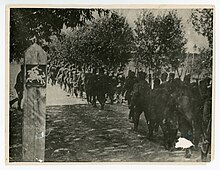
In October 1939, Lithuania was forced to sign the Soviet–Lithuanian Mutual Assistance Treaty: five Soviet military bases with 20,000 troops were established in Lithuania in exchange for Vilnius, which the Soviets had captured from Poland.[94] Delayed by the Winter War with Finland, the Soviets issued an ultimatum to Lithuania on 14 June 1940. They demanded the replacement of the Lithuanian government and that the Red Army be allowed into the country. The government decided that, with Soviet bases already in Lithuania, armed resistance was impossible and accepted the ultimatum.[95] President Smetona left the country, hoping to form a government in exile, while more than 200,000 Soviet Red Army soldiers crossed the Belarus–Lithuania border.[96] The next day, identical ultimatums were presented to Latvia and Estonia. The Baltic states were occupied. The Soviets followed semi-constitutional procedures for transforming the independent countries into soviet republics and incorporating them into the Soviet Union.
Vladimir Dekanozov was sent to supervise the formation of the puppet People's Government and the rigged election to the People's Seimas. The Lithuanian Soviet Socialist Republic was proclaimed on 21 July and accepted into the Soviet Union on 3 August. Lithuania was rapidly Sovietized: political parties and various organizations (except the Communist Party of Lithuania) were outlawed, some 12,000 people, including many prominent figures, were arrested and imprisoned in Gulag as "enemies of the people", larger private property was nationalized, the Lithuanian litas was replaced by the Soviet rouble, farm taxes were increased by 50–200%, the Lithuanian Army was transformed into the 29th Rifle Corps of the Red Army.[97] On 14–18 June 1941, less than a week before the Nazi invasion, some 17,000 Lithuanians were deported to Siberia, where many perished due to inhumane living conditions (see the June deportation).[98][99] The occupation was not recognized by Western powers and the Lithuanian Diplomatic Service, based on pre-war consulates and legations, continued to represent independent Lithuania until 1990.

When Nazi Germany attacked the Soviet Union on 22 June 1941, Lithuanians began the anti-Soviet June Uprising, organized by the Lithuanian Activist Front. Lithuanians proclaimed independence and organized the Provisional Government of Lithuania. This government quickly self-disbanded.[100] Lithuania became part of the Reichskommissariat Ostland, German civil administration.[101]

By 1 December 1941, over 120,000 Lithuanian Jews, or 91–95% of Lithuania's pre-war Jewish community, had been killed.[102]: 110 Nearly 100,000 Jews, Poles, Russians and Lithuanians were murdered at Paneriai.[103] However, thousands of Lithuanian families risking their lives also protected Jews from the Holocaust.[104] Israel has recognized 918 Lithuanians (as of 1 January 2021) as Righteous Among the Nations for risking their lives to save Jews during the Holocaust.[105]
Approximately 13,000 men served in the Lithuanian Auxiliary Police Battalions.[106] 10 of the 26 Lithuanian Auxiliary Police Battalions working with the Nazi Einsatzkommando, were involved in the mass killings. Rogue units organised by Algirdas Klimaitis and supervised by SS Brigadeführer Walter Stahlecker started the Kaunas pogrom in and around Kaunas on 25 June 1941.[107][108] In 1941, the Lithuanian Security Police (Lietuvos saugumo policija), subordinate to Nazi Germany's Security Police and Nazi Germany's Criminal Police, was created. The Lietuvos saugumo policija targeted the communist underground.[109]
A new occupation had begun. Nationalized assets were not returned to the residents. Some of them were forced to fight for Nazi Germany or were taken to German territories as forced labourers. Jewish people were herded into ghettos and gradually killed by shooting or sending them out to concentration camps.[110][111]
1944–1990
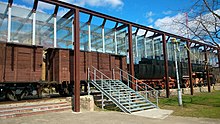
After the retreat of the German armed forces, the Soviets reestablished their control of Lithuania in July–October 1944. The massive deportations to Siberia were resumed and lasted until the death of Stalin in 1953. Antanas Sniečkus, the leader of the Communist Party of Lithuania from 1940 to 1974,[112] supervised the arrests and deportations.[113] All Lithuanian national symbols were banned. Under the pretext of Lithuania's economic recovery, the Moscow authorities encouraged the migration of workers and other specialists to Lithuania with the intention to further integrate Lithuania into the Soviet Union and to develop the country's industry. At the same time, Lithuanians were lured to work in the USSR by promising them all the privileges of settling in a new place.
The second Soviet occupation was accompanied by the guerrilla warfare of the Lithuanian population, which took place in 1944–1953. It sought to restore an independent state of Lithuania, to consolidate democracy by destroying communism in the country, returning national values and the freedom of religion. About 50,000 Lithuanians took to the forests and fought Soviet occupants with a gun in their hands.[114][115] In the later stages of the partisan war, Lithuanians formed the Union of Lithuanian Freedom Fighters and its leader Jonas Žemaitis (codename Vytautas) was posthumously recognized as the president of Lithuania.[116] Despite the fact that the guerrilla warfare did not achieve its goal of liberating Lithuania and that it resulted in more than 20,000 deaths, the armed resistance de facto demonstrated that Lithuania did not voluntarily join the USSR and it also legitimized the will of the people of Lithuania to be independent.[117] Lithuanian courts and the ECHR both treat the Soviets' annihilation of the Lithuanian partisans as a genocide.[118]
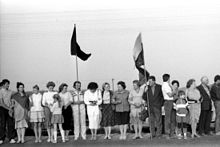
Even with the suppression of partisan resistance, the Soviet government failed to stop the movement for the independence of Lithuania. The underground dissident groups were active publishing the underground press and Catholic literature. The most active participants of the movement included Vincentas Sladkevičius, Sigitas Tamkevičius and Nijolė Sadūnaitė. In 1972, after Romas Kalanta's public self-immolation, the unrest in Kaunas lasted for several days.[119]
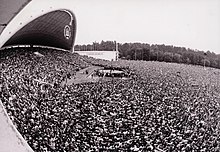
The Helsinki Group, which was founded in Lithuania after the international conference in Helsinki (Finland), where the post-WWII borders were acknowledged, announced a declaration for Lithuania's independence on foreign radio station.[120] The Helsinki Group informed the Western world about the situation in the Soviet Lithuania and violations of human rights. With the beginning of the increased openness and transparency in government institutions and activities (glasnost) in the Soviet Union, on 3 June 1988, the Sąjūdis was established in Lithuania with Romualdas Ozolas acting as the key figure of the movement. Very soon it began to seek the country's independence.[121] Eventually, Vytautas Landsbergis became the movement's leader.[122] The supporters of Sąjūdis joined movement's groups all over Lithuania. On 23 August 1988 a large rally took place at the Vingis Park in Vilnius. It was attended by approx. 250,000 people.[123] A year later, on 23 August 1989 commemorating the 50th anniversary of the Molotov-Ribbentrop Pact and aiming to draw the attention of the whole world to the occupation of the Baltic states, a political demonstration, the Baltic Way, was organized.[124] The event, led by Sąjūdis, was a human chain spanning 600 kilometres (370 mi) across Vilnius, Riga and Tallinn, indicating the desire of the people of Lithuania, Latvia, and Estonia to break away from the Soviet Union.
1990–present
On 11 March 1990, the Supreme Council announced the restoration of Lithuania's independence. Lithuania became the first Soviet-occupied state to announce the restitution of independence. On 20 April 1990, the Soviets imposed an economic blockade by ceasing to deliver supplies of raw materials (primarily oil) to Lithuania.[126] Not only the domestic industry, but also the population started feeling the lack of fuel, essential goods, and even hot water. Although the blockade lasted for 74 days, Lithuania did not renounce the declaration of independence.
Gradually, economic relations had been restored. However, tensions had peaked again in January 1991. At that time, attempts were made to carry out a coup using the Soviet Armed Forces, the Internal Army of the Ministry of Internal Affairs and the USSR Committee for State Security (KGB). Because of the poor economic situation in Lithuania, the forces in Moscow thought the coup d'état would receive strong public support.[127]
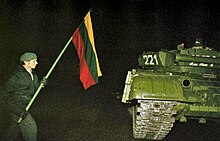
People from all over Lithuania flooded to Vilnius to defend the Supreme Council of the Republic of Lithuania and independence. The coup ended with a few casualties of peaceful civilians and caused huge material loss. Not a single person who defended Lithuanian Parliament or other state institutions used a weapon, but the Soviet Army did, killing 14 people and injured hundreds. A large part of the Lithuanian population participated in the January Events.[129][130] Shortly after, on 11 February 1991, the Icelandic parliament voted to confirm that Iceland's 1922 recognition of Lithuanian independence was still in full effect, as it never formally recognized the Soviet Union's control over Lithuania,[131] and that full diplomatic relations should be established as soon as possible.[132][133]
On 31 July 1991, Soviet paramilitaries killed seven Lithuanian border guards on the Belarusian border in what became known as the Medininkai Massacre.[134] On 17 September 1991, Lithuania was admitted to the United Nations.
On 25 October 1992, the citizens of Lithuania voted in a referendum to adopt the current constitution. On 14 February 1993, during the direct general elections, Algirdas Brazauskas became the first president after the restoration of independence of Lithuania. On 31 August 1993 the last units of the former Soviet Army left the territory of Lithuania.[135]
On 31 May 2001, Lithuania joined the World Trade Organization (WTO).[136] Since 29 March 2004, Lithuania has been part of NATO.[137] On 1 May 2004, it became a fully-fledged member of the European Union,[138] and a member of the Schengen Agreement on 21 December 2007.[139] On 1 January 2015, Lithuania joined the eurozone and adopted the European Union's single currency as the last of the Baltic states.[140] On 4 July 2018, Lithuania officially joined OECD.[141]
Dalia Grybauskaitė was the first female President of Lithuania (2009–2019) and the first president to be re-elected for a second consecutive term.[142]
On 24 February 2022, Lithuania declared a state of emergency in response to the 2022 Russian invasion of Ukraine.[143] Together with the eight other NATO member states, the country also invoked NATO Article 4 to hold consultations on security.[144] On 11–12 July 2023, the 2023 NATO summit was held in Vilnius.[145]
Geography

Lithuania is located in the Baltic region of Europe[a] and covers an area of 65,300 km2 (25,200 sq mi).[146] It lies between latitudes 53° and 57° N, and mostly between longitudes 21° and 27° E (part of the Curonian Spit lies west of 21°). It has around 99 kilometres (61.5 mi) of sandy coastline, only about 38 kilometres (24 mi) of which face the open Baltic Sea, less than the other two Baltic states. The rest of the coast is sheltered by the Curonian sand peninsula. Lithuania's major warm-water port, Klaipėda, lies at the narrow mouth of the Curonian Lagoon (Lithuanian: Kuršių marios), a shallow lagoon extending south to Kaliningrad. The country's main and largest river, the Nemunas River, and some of its tributaries carry international shipping.
Lithuania lies at the edge of the North European Plain. Its landscape was smoothed by the glaciers of the last ice age, and is a combination of moderate lowlands and highlands. Its highest point is Aukštojas Hill at 294 metres (965 ft) in the eastern part of the country. The terrain features numerous lakes (Lake Vištytis, for example) and wetlands, and a mixed forest zone covers over 33% of the country. Drūkšiai is the largest, Tauragnas is the deepest and Asveja is the longest lake in Lithuania.
After a re-estimation of the boundaries of the continent of Europe in 1989, Jean-George Affholder, a scientist at the Institut Géographique National (French National Geographic Institute), determined that the geographic centre of Europe was in Lithuania, at 54°54′N 25°19′E / 54.900°N 25.317°E, 26 kilometres (16 mi) north of Lithuania's capital city of Vilnius.[147] Affholder accomplished this by calculating the centre of gravity of the geometrical figure of Europe.
Climate
Lithuania has a temperate climate with both maritime and continental influences. It is defined as humid continental (Dfb) under the Köppen climate classification (but is close to oceanic in a narrow coastal zone).
Average temperatures on the coast are −2.5 °C (27.5 °F) in January and 16 °C (61 °F) in July. In Vilnius the average temperatures are −6 °C (21 °F) in January and 17 °C (63 °F) in July. During the summer, 20 °C (68 °F) is common during the day while 14 °C (57 °F) is common at night; in the past, temperatures have reached as high as 30 or 35 °C (86 or 95 °F). Some winters can be very cold. −20 °C (−4 °F) occurs almost every winter. Winter extremes are −34 °C (−29 °F) in coastal areas and −43 °C (−45 °F) in the east of Lithuania.
The average annual precipitation is 800 mm (31.5 in) on the coast, 900 mm (35.4 in) in the Samogitia highlands and 600 mm (23.6 in) in the eastern part of the country. Snow occurs every year, it can snow from October to April. In some years sleet can fall in September or May. The growing season lasts 202 days in the western part of the country and 169 days in the eastern part. Severe storms are rare in the eastern part of Lithuania but common in the coastal areas.
The longest records of measured temperature in the Baltic area cover about 250 years. The data show warm periods during the latter half of the 18th century, and that the 19th century was a relatively cool period. An early 20th-century warming culminated in the 1930s, followed by a smaller cooling that lasted until the 1960s. A warming trend has persisted since then.[148]
Lithuania experienced a drought in 2002, causing forest and peat bog fires.[149]
Environment
After the restoration of Lithuania's independence in 1990, the Aplinkos apsaugos įstatymas (Environmental Protection Act) was adopted already in 1992. The law provided the foundations for regulating social relations in the field of environmental protection, established the basic rights and obligations of legal and natural persons in preserving the biodiversity inherent in Lithuania, ecological systems and the landscape.[151] Lithuania agreed to cut carbon emissions by at least 20% of 1990 levels by 2020 and by at least 40% by 2030, together with all European Union members. Also, by 2020 at least 20% (27% by 2030) of the country's total energy consumption should be from the renewable energy sources.[152] In 2016, Lithuania introduced especially effective container deposit legislation, which resulted in collecting 92% of all packagings in 2017.[153]
Lithuania does not have high mountains and its landscape is dominated by blooming meadows, dense forests and fertile fields of cereals. However, it stands out by the abundance of hillforts, which previously had castles where the ancient Lithuanians burned altars for pagan gods.[154] Lithuania is a particularly watered region with more than 3,000 lakes, mostly in the northeast. The country is also drained by numerous rivers, most notably the longest Nemunas.[154] Lithuania is home to two terrestrial ecoregions: Central European mixed forests and Sarmatic mixed forests.[155]
Forest has long been one of the most important natural resources in Lithuania. Forests occupy one-third of the country's territory and timber-related industrial production accounts for almost 11% of industrial production in the country.[156] Lithuania has five national parks,[157] 30 regional parks,[158] 402 nature reserves,[159] 668 state-protected natural heritage objects.[160]
In 2018 Lithuania was ranked fifth, second to Sweden (first 3 places were not granted) in the Climate Change Performance Index (CCPI).[161] It had a 2019 Forest Landscape Integrity Index mean score of 1.62/10, ranking it 162nd globally out of 172 countries.[162]
Biodiversity

Lithuanian ecosystems include natural and semi-natural (forests, bogs, wetlands and meadows), and anthropogenic (agrarian and urban) ecosystems. Among natural ecosystems, forests are particularly important to Lithuania, covering 33% of the country's territory. Wetlands (raised bogs, fens, transitional mires, etc.) cover 7.9% of the country, with 70% of wetlands having been lost due to drainage and peat extraction between 1960 and 1980. Changes in wetland plant communities resulted in the replacement of moss and grass communities by trees and shrubs, and fens not directly affected by land reclamation have become drier as a result of a drop in the water table. There are 29,000 rivers with a total length of 64,000 km in Lithuania, the Nemunas River basin occupying 74% of the territory of the country. Due to the construction of dams, approximately 70% of spawning sites of potential catadromous fish species have disappeared. In some cases, river and lake ecosystems continue to be impacted by anthropogenic eutrophication.[165]
Agricultural land comprises 54% of Lithuania's territory (roughly 70% of that is arable land and 30% meadows and pastures), approximately 400,000 ha of agricultural land is not farmed, and acts as an ecological niche for weeds and invasive plant species. Habitat deterioration is occurring in regions with very productive and expensive lands as crop areas are expanded. Currently, 18.9% of all plant species, including 1.87% of all known fungi species and 31% of all known species of lichens, are listed in the Lithuanian Red Data Book. The list also contains 8% of all fish species.[165]
The wildlife populations have rebounded as the hunting became more restricted and urbanization allowed replanting forests (forests already tripled in size since their lows). Currently, Lithuania has approximately 250,000 larger wild animals or 5 per each square kilometre. The most prolific large wild animal in every part of Lithuania is the roe deer, with 120,000 of them. They are followed by boars (55,000). Other ungulates are the deer (~22,000), fallow-deer (~21,000) and the largest one: moose (~7,000). Among the Lithuanian predators, foxes are the most common (~27,000). Wolves are, however, more ingrained into the mythology as there are just 800 in Lithuania. Even rarer are the lynxes (~200). The large animals mentioned above exclude the rabbit, ~200,000 of which may live in the Lithuanian forests.[166]
Government and politics

Government
Since Lithuania declared the restoration of its independence on 11 March 1990, it has maintained strong democratic traditions. It held its first independent general elections on 25 October 1992, in which 56.75% of voters supported the new constitution.[167] There were intense debates concerning the constitution, particularly the role of the president. A separate referendum was held on 23 May 1992 to gauge public opinion on the matter, and 41% of voters supported the restoration of the President of Lithuania.[167] Through compromise, a semi-presidential system was agreed on.[4]
The Lithuanian head of state is the president, directly elected for a five-year term and serving a maximum of two terms. The president oversees foreign affairs and national security, and is the commander-in-chief of the military.[168] The president also appoints the prime minister and, on the latter's nomination, the rest of the cabinet, as well as a number of other top civil servants and the judges for all courts except the Constitutional Court.[168] The current Lithuanian head of state, Gitanas Nausėda was elected on 26 May 2019 by unanimously winning in all municipalities of Lithuania on the second election tour.[169]
The judges of the Constitutional Court (Konstitucinis Teismas) serve nine-year terms. The court is renewed by a third every three years. The judges are appointed by the Seimas, on the nomination of the President, Chairman of the Seimas, and the Chairman of the Supreme Court,. The unicameral Lithuanian parliament, the Seimas, has 141 members who are elected to four-year terms. 71 of the members of its members are elected in single-member constituencies, and the others in a nationwide vote by proportional representation. A party must receive at least 5% of the national vote to be eligible for any of the 70 national seats in the Seimas.[170]
Political parties and elections
Lithuania was one of the first countries in the world to grant women a right to vote in the elections. Lithuanian women were allowed to vote by the 1918 Constitution of Lithuania and used their newly granted right for the first time in 1919. By doing so, Lithuania allowed it earlier than such democratic countries as the United States (1920), France (1945), Greece (1952), Switzerland (1971).[171]
Lithuania exhibits a fragmented multi-party system,[172] with a number of small parties in which coalition governments are common. Ordinary elections to the Seimas take place on the second Sunday of October every four years.[170] To be eligible for election, candidates must be at least 25 years old on the election day, not under allegiance to a foreign state and permanently reside in Lithuania. Persons serving or due to serve a sentence imposed by the court 65 days before the election are not eligible. Also, judges, citizens performing military service, and servicemen of professional military service and officials of statutory institutions and establishments may not stand for election.[173] Homeland Union – Lithuanian Christian Democrats won the 2020 Lithuanian parliamentary elections and gained 50 of 141 seats in the parliament.[174] In October 2020, the prime ministerial candidate of Homeland Union-Lithuanian Christian Democrats (TS-LKD) Ingrida Šimonytė formed a centre-right coalition with two liberal parties.[175]

The President of Lithuania is the head of state of the country, elected to a five-year term in a majority vote. Elections take place on the last Sunday no more than two months before the end of current presidential term.[176] To be eligible for election, candidates must be at least 40 years old on the election day and reside in Lithuania for at least three years, in addition to satisfying the eligibility criteria for a member of the parliament. Same President may serve for not more than two terms.[177] Gitanas Nausėda has won the most recent election as an independent candidate in 2019.[169]
Each municipality in Lithuania is governed by a municipal council and a mayor, who is a member of the municipal council. The number of members, elected on a four-year term, in each municipal council depends on the size of the municipality and varies from 15 (in municipalities with fewer than 5,000 residents) to 51 (in municipalities with more than 500,000 residents). 1,524 municipal council members were elected in 2015.[178] Members of the council, with the exception of the mayor, are elected using proportional representation. Starting with 2015, the mayor is elected directly by the majority of residents of the municipality.[179] Social Democratic Party of Lithuania won most of the positions in the 2015 elections (372 municipal councils seats and 16 mayors).[180]
As of 2019, the number of seats in the European Parliament allocated to Lithuania was 11.[181] Ordinary elections take place on a Sunday on the same day as in other EU countries. The vote is open to all citizens of Lithuania, as well as citizens of other EU countries that permanently reside in Lithuania, who are at least 18 years old on the election day. To be eligible for election, candidates must be at least 21 years old on the election day, a citizen of Lithuania or a citizen of another EU country permanently residing in Lithuania. Candidates are not allowed to stand for election in more than one country. Persons serving or due to serve a sentence imposed by the court 65 days before the election are not eligible. Also, judges, citizens performing military service, and servicemen of professional military service and officials of statutory institutions and establishments may not stand for election.[182] Six political parties and one committee representatives gained seats in the 2019 elections.[183]
Law and law enforcement
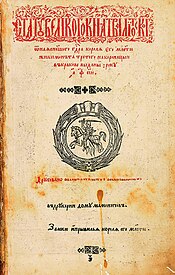
The first attempt to codify the Lithuanian laws was in 1468 when the Casimir's Code was compiled and adopted by Grand Duke Casimir IV Jagiellon.[184] In the 16th century three editions of the Statutes of Lithuania were created with the First Statute being adopted in 1529, the Second Statute in 1566, and the Third Statute in 1588.[184] On 3 May 1791, the Europe's first and the world's second Constitution was adopted by the Great Sejm.[185] The Third Statute was partly in force in the territory of Lithuania even until 1840, despite the Third Partition of the Polish–Lithuanian Commonwealth in 1795.[184]
In 1934–1935, Lithuania held the first mass trial of the Nazis in Europe, the convicted were sentenced to imprisonment in a heavy labor prison and capital punishments.[186]
After regaining of independence in 1990, the largely modified Soviet legal codes were in force for about a decade. The current Constitution of Lithuania was adopted on 25 October 1992.[187] In 2001, the Civil Code of Lithuania was passed in Seimas. It was succeeded by the Criminal Code and Criminal Procedure Code in 2003. The approach to the criminal law is inquisitorial, as opposed to adversarial; it is generally characterised by an insistence on formality and rationalisation, as opposed to practicality and informality. Normative legal act enters into force on the next day after its publication in the Teisės aktų registras, unless it has a later entry into force date.[188]
The European Union law is an integral part of the Lithuanian legal system since 1 May 2004.[189]
Lithuania, after breaking away from the Soviet Union, had a difficult crime situation, however, the Lithuanian law enforcement agencies fought crime over the years, making Lithuania a reasonably safe country.[190] Crime in Lithuania has been declining rapidly.[191] Law enforcement in Lithuania is primarily the responsibility of local Lietuvos policija (Lithuanian Police) commissariats. They are supplemented by the Lietuvos policijos antiteroristinių operacijų rinktinė Aras (Anti-Terrorist Operations Team of the Lithuanian Police Aras), Lietuvos kriminalinės policijos biuras (Lithuanian Criminal Police Bureau), Lietuvos policijos kriminalistinių tyrimų centras (Lithuanian Police Forensic Research Center) and Lietuvos kelių policijos tarnyba (Lithuanian Road Police Service).[192]
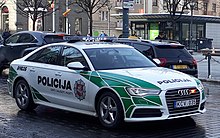
In 2017, there were 63,846 crimes registered in Lithuania. Of these, thefts comprised a large part with 19,630 cases (13.2% less than in 2016). While 2,835 crimes were serious and very serious (crimes that may lead to more than six years imprisonment), which is 14.5% less than in 2016. In total, 129 homicides or attempted homicide occurred (19.9% less than in 2016), while serious bodily harm was registered 178 times (17.6% less than in 2016). Another problematic crime contraband cases also decreased by 27.2% from 2016 numbers. Meanwhile, crimes in electronic data and information technology security fields noticeably increased by 26.6%.[193] In the 2013 Special Eurobarometer, 29% of Lithuanians said that corruption affects their daily lives (EU average 26%). Moreover, 95% of Lithuanians regarded corruption as widespread in their country (EU average 76%), and 88% agreed that bribery and the use of connections is often the easiest way of obtaining certain public services (EU average 73%).[194] Though, according to local branch of Transparency International, corruption levels have been decreasing over the past decade.[195]
Capital punishment in Lithuania was suspended in 1996 and eliminated in 1998.[196] Lithuania has the highest number of prison inmates in the EU. According to scientist Gintautas Sakalauskas, this is not because of a high criminality rate in the country, but due to Lithuania's high repression level and the lack of trust of the convicted, who are frequently sentenced to imprisonment.[197]
Administrative divisions

The current system of administrative division was established in 1994 and modified in 2000 to meet the requirements of the European Union. The country's 10 counties (Lithuanian: singular – apskritis, plural – apskritys) are subdivided into 60 municipalities (Lithuanian: singular – savivaldybė, plural – savivaldybės), and further divided into 500 elderships (Lithuanian: singular – seniūnija, plural – seniūnijos).
Municipalities have been the most important unit of administration in Lithuania since the system of county governorship (apskrities viršininkas) was dissolved in 2010.[198] Some municipalities are historically called "district municipalities" (often shortened to "district"), while others are called "city municipalities" (sometimes shortened to "city"). Each has its own elected government. The election of municipality councils originally occurred every three years, but now takes place every four years. The council appoints elders to govern the elderships. Mayors have been directly elected since 2015; prior to that, they were appointed by the council.[199]
Elderships, numbering over 500, are the smallest administrative units and do not play a role in national politics. They provide necessary local public services—for example, registering births and deaths in rural areas. They are most active in the social sector, identifying needy individuals or families and organizing and distributing welfare and other forms of relief.[200] Some citizens feel that elderships have no real power and receive too little attention, and that they could otherwise become a source of local initiative for addressing rural problems.[201]




